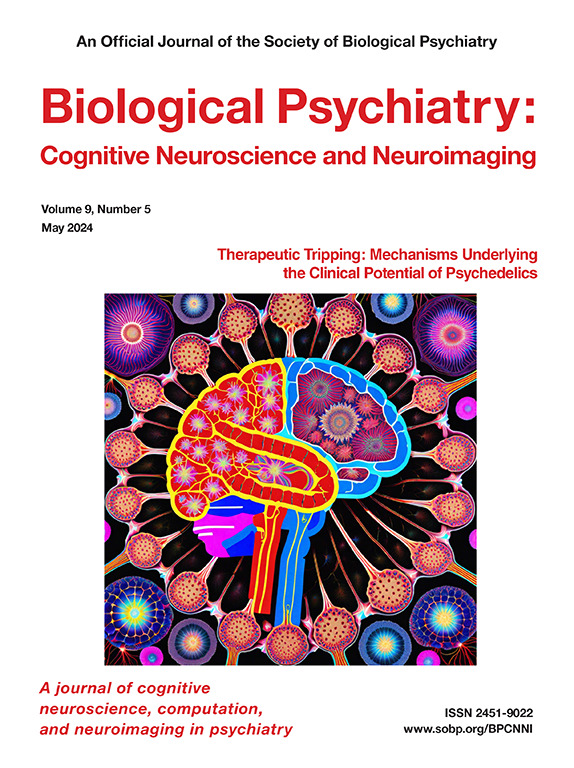Current Status of Electroencephalography Microstate in Psychiatric Disorders: A Systematic Review and Meta-Analysis
IF 4.8
2区 医学
Q1 NEUROSCIENCES
Biological Psychiatry-Cognitive Neuroscience and Neuroimaging
Pub Date : 2025-10-01
DOI:10.1016/j.bpsc.2025.04.001
引用次数: 0
Abstract
Background
Electroencephalography microstates are promising biomarkers for psychiatric conditions, although prior meta-analyses mainly focused on schizophrenia (SCH) and mood disorders. This study expands the analysis to a wider range of mental disorders, examining microstate variations across the psychosis and mood spectra and assessing medication effects in SCH.
Methods
Following Preferred Reporting Items for Systematic Reviews and Meta-Analyses (PRISMA) guidelines, we conducted a comprehensive literature search, identifying 24 studies meeting inclusion criteria. Analyses were performed across 2 psychiatric subgroups: psychotic disorders and mood disorders. We further conducted a subgroup analysis within the SCH spectrum to examine differences in microstate properties between medicated and unmedicated patients.
Results
Microstate C demonstrated a significant increase in coverage and occurrence in patients with SCH, first-episode psychosis, and high risk of psychosis and increased duration in SCH. The absence of increased occurrence in medicated patients with SCH suggests that this feature may be state dependent or modulated by treatment. In contrast, microstate D exhibited significant decreases in duration and coverage in unmedicated patients with SCH, indicating potential links with acute psychotic states.
Conclusions
Our findings suggest that microstates C and D could serve as potential biomarkers in SCH, with microstate D alterations linked to acute psychotic symptoms and microstate C potentially reflecting a chronic course or treatment effects. These results emphasize the clinical potential of microstate analysis in psychotic disorder diagnosis and treatment monitoring. The literature on microstate variations in neurodevelopmental and mood disorders is limited, highlighting the need for further research to determine their biomarker potential in these conditions.
脑电图微状态在精神疾病中的现状:系统回顾和荟萃分析。
背景:脑电图微状态是有希望的精神疾病的生物标志物,尽管先前的荟萃分析主要集中在精神分裂症和情绪障碍。这项研究将分析扩展到更广泛的精神障碍,检查精神病和情绪谱的微观状态变化,并评估药物对精神分裂症的影响。方法:遵循PRISMA指南,我们进行了全面的文献检索,确定了24项符合纳入标准的研究。对两个精神病学亚组进行了分析:精神障碍和情绪障碍。我们进一步在精神分裂症谱系中进行了亚组分析,以检查服药和未服药患者之间微观状态特性的差异。结果:微状态C在精神分裂症、首发精神病和精神病高危患者中的覆盖率和发生率显著增加,精神分裂症持续时间增加。在接受药物治疗的精神分裂症患者中没有增加的发生率表明,这一特征可能是状态依赖性的或受治疗调节的。相比之下,在未服药的精神分裂症患者中,微状态D的持续时间和覆盖范围显著减少,表明与急性精神病状态有潜在的联系。结论:我们的研究结果表明,微状态C和D可以作为精神分裂症的潜在生物标志物,微状态D的改变与急性精神病症状有关,而微状态C可能反映慢性病程或治疗效果。这些结果强调了微观状态分析在精神障碍诊断和治疗监测中的临床潜力。关于神经发育和情绪障碍的微观状态变化的文献是有限的,强调需要进一步研究以确定它们在这些条件下的生物标志物潜力。
本文章由计算机程序翻译,如有差异,请以英文原文为准。
求助全文
约1分钟内获得全文
求助全文
来源期刊

Biological Psychiatry-Cognitive Neuroscience and Neuroimaging
Neuroscience-Biological Psychiatry
CiteScore
10.40
自引率
1.70%
发文量
247
审稿时长
30 days
期刊介绍:
Biological Psychiatry: Cognitive Neuroscience and Neuroimaging is an official journal of the Society for Biological Psychiatry, whose purpose is to promote excellence in scientific research and education in fields that investigate the nature, causes, mechanisms, and treatments of disorders of thought, emotion, or behavior. In accord with this mission, this peer-reviewed, rapid-publication, international journal focuses on studies using the tools and constructs of cognitive neuroscience, including the full range of non-invasive neuroimaging and human extra- and intracranial physiological recording methodologies. It publishes both basic and clinical studies, including those that incorporate genetic data, pharmacological challenges, and computational modeling approaches. The journal publishes novel results of original research which represent an important new lead or significant impact on the field. Reviews and commentaries that focus on topics of current research and interest are also encouraged.
 求助内容:
求助内容: 应助结果提醒方式:
应助结果提醒方式:


